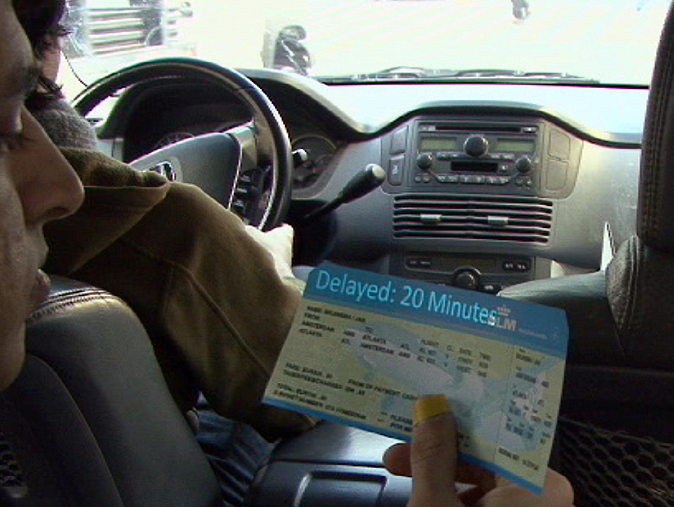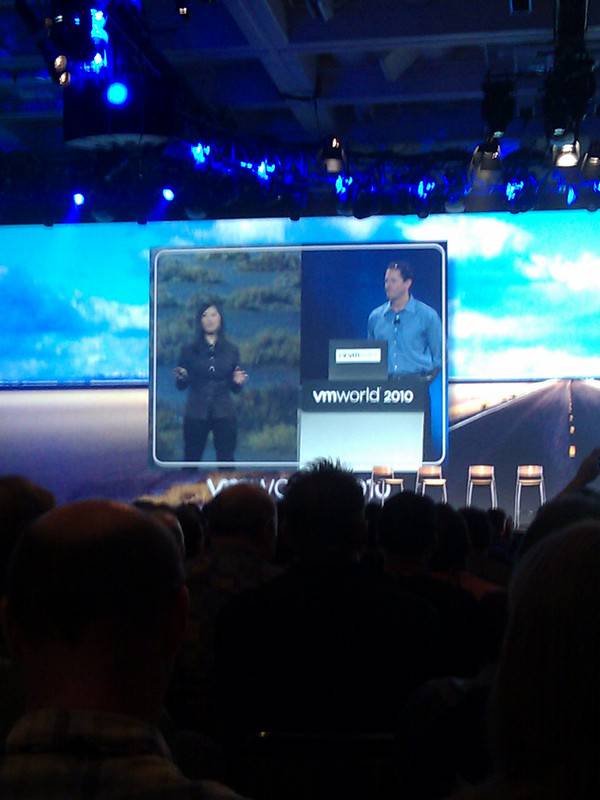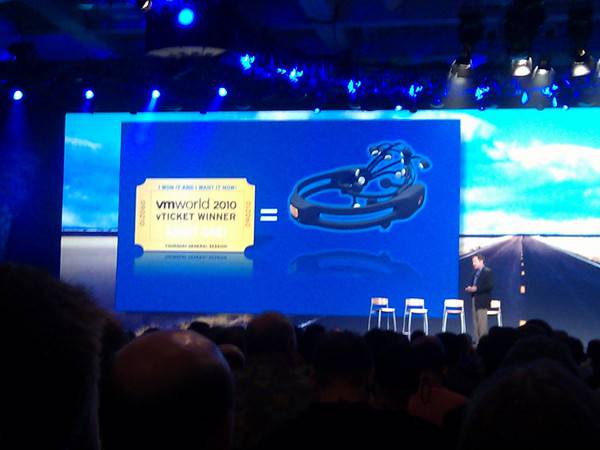VMware
|
Sep 3, 2010
Do you want to know what the cloud is? Watch this and learn.
[youtube]cxpmyla-IXU[/youtube]
One of the better opening keynotes in a while. It answers the question of "What is the cloud?" in a way that everyone can agree on. Thanks to @jtroyer & @tony_dunn for getting this available.
Continue reading »
VMware
|
Sep 2, 2010
VMworld 2010 is coming to a close. This has been a very different ride than previous VMworlds in my experience. So stay tuned for my wrap up.
This is a live blog posting.
Richard - Chief Marketing Officer
vTicket - The Golden Ticket - You will just have to wait and see what they win (must be present to win).
13,000 labs so far - over 150k VMs
Ron Davis took all 30 labs first (yes.. took all 30 labs available)
Innovation:
#1 Doing something new
Early on the Mainframe saw that they were severely under utilized and created virtualization.
#2 Changing the way things are done
VMware first started changing the way in 2001 in the datacenter
Update: 9:06am:
Discussion on the future of end user experience:
Pranav Mistry from the MIT Media Lab. Created Sixth Sense.
The question is when connecting devices (just a few) in a way to interact with the cloud (internet).
He created an interface to interact with the objects inside the computer. What about using paper? What about working in spatial?
The next way is making ordinary objects be able to interact with the cloud. How do we make interaction with computers simpler? Do we really care about computers or do we care about the information instead?
If we take the information out of the computers we can tie that information to the real world objects. We take and project those pixels then we can start interacting with them outside the computer. Say you have an airplane ticket, if a camera can take the information in, why can't it then check if the flight is on time and then display that information onto the ticket with a little projector.

http://www.pranavmistry.com/projects/sixthsense/
Update 9:25am:
Natan Linder - MIT Media Lab
Adding I/O to the real world. What if anywhere we have a plug/power we can interact with the Web? Project LuminAR. What if you plug a computer interface into a light socket that can respond to what your doing? Bring up a webpage/youtube about the book your currently reading and project it onto the desk your sitting at. Tie that in with a robot that can help you out based on your guestures and environment needs.
Update 9:35am:
Tan Le - Emotiv Systems
Brain computing interface. All communication with computers is specific commands. With humans there are many more layers of communication from feelings, emotions, facial experssions, experience. What if we can bring those data points into the computer?
The issue with brain computing is everyone's brain works a little bit differently. Emotiv has developed an algorithm to help this mapping. The second issue is the physical interface to be able to get the signals from a human head. This headset is cost manageable now.
Steve Herrod, What a great sport getting up on stage and using the Emotiv Headset for a live demostration. Incredible technology.

Closing: vTicket == Emotiv Headset

Update 3 Sep 2010: Fixed the pictures as they weren't showing up right.
Continue reading »
VMware
|
Aug 31, 2010
Hello one and all. Its a Live Blog going down today. Enjoy the live blogging and check out @iankoenig on twitter for even more live information.
Update 9:04am:
Hanging out with Virtualization-spotlight.com owner chatting about the cloud. Waiting for the session to start. What coolness do we have this year?
Update: 9:10am:
The opening presentation video asks the great question of "What is the cloud?". A cute Matrix like fun here.. A great quote:
- The cloud is in your mind from the Oracle (not that company that needs some help)

17,021 total as of Monday night
55 people attended all 7 VMworlds - The Alumni Elite
Update: 9:27am
Virtual Roads. Actual Clouds. The theme this year.
Starting down this road and it is a journey:
Most customers start with cost efficiency. They find that money savings are huge. As they use it they find out that VMs are easier to manage and use.
The next step is Quality of Service. Businesses find out that can get more reliability without the high cost of delivery. Many applications run better as virtual machines. Sharepoint/Exchange are mentioned all the time to VMware that it is better.
The latest step this year is IT as a Service (ITaaS). Phase 3 is all about agility. How can IT offer computer resources for giving the business the ability to quickly consume these resources to get to value faster is the question?
IT as a Service == Optimizing IT production for business consumption.
Update 9:30am:
Some of the great innovations is that by having OS instances that aren't owning the hardware means you have options. Large change in how IT addresses computing.
Can start talking about the computer food groups of compute, storage, network, security and work on decreasing OpEx and enhancing security. One item that has been missing out of this has been security and is now a serious focus by VMware.
Now because we can separate from hardware and have defined what a datacenter is we can start abstracting away from the datacenter itself and virtualize that.
Realistically Hybrid Cloud is the right approach by Paul Martiz. We need management. We need standards.
Update 9:39am:
The current solutions really address the old applications and approaches. The next true step is how can we make new applications more scalable and cloud friendly. So a new application platform needs to be defined and delivered. What are the common services they need?
Common Management, Common Services and Open frameworks. These frameworks have to be able to handle whatever programming languages are coming. Every time you tie to a language someone will come along with a new language that solves some problem. Need to stay away form that wherever we can.
These Frameworks also need to connect to different clouds. Google App Engine, vmForce, vCloud.
Update 9:47am:
Different devices are coming into the business environment. IT has no choice on this. It will come one way or another and IT will need to figure out how to deliver secure, manageable approaches. iPads are coming in over night.
The third layer of innovation needed called "New End User Access". This is the stack that is now the new IT one for the cloud era.
Update 9:51am:
Steve Herrod's turn to show the details of the theory from Paul Maritz.
Again vSphere is the basis of this all. Can really deliver and is getting better and faster on every release. Policy driven SLAs with Network IO control and Storage IO control. If you know about vSphere 4.1 already this part is a good review.
Integrien, the acquisition of the day. VMware is buying them for their proactive heatmap style management and allocation. This is a new style of management to show the tons of information in easier to process displays. Very graphical.
Update 10:02am:
Herrod: For IT as a Service is key about moving to offering an "App Store" for clients at the business. They want services, not VMs. They want a database server, web server. Not a Windows/Linux/Unix box generally.
Virtual Datacenters are a key way to discuss this. To provide the services you define the SLAs an function of that datacenter. So you can setup just what you need and what levels are necessary.
vCloud Director is live. This is the key management tool for this entire environment.
Update 10:12am:
vShield platform is a critical to making the Cloud work. Need a common set of services that will offer some basic security available everywhere. This is both on the private and the public cloud. vCloud Director is on both sides of the fence and offers the same functionality everywhere and can span the private to the public in a secure way.
Update 10:26am:
Now we are on the Application platform layer and is what vFabric is all about. It is a common set of services available to make new application cloud friendly. The great thing about this is it will work with Ruby, Python, Java etc.
Update 10:27am:
The final area is the End User Computing experience. View 4.5 is the part of modernizing the desktop direction. Released today. View 4.5 has the ability to lower the cost of acquistion below $500 a system which is below the physical desktop costs.
The now is to call User-centric IT. We need to get away from PC Centric. Most consumers are use to using any device. Why not move to User focused?
Project Horizon demo going on. This is focused around User-Centric IT. This allows you to have whatever applications you are licensed are immediately provisioned to your virtual workstation. Single sign on and user focused. Not device. Some applications may not work well on a given devices.
A good demo of View iPad client with Project Horizon. This is the future of IT.
Update: 3 Sept 2010 - Fixed the company name (Integrien) that VMware bought
Continue reading »
VMware
|
Aug 31, 2010
VMware has announced the new product VMware vCloud Director (vCD from now on). I've read the early blog posts and been in some conversations and know at this point I just can't give it any justice. The short view it is virtualizing a datacenter into software and then managing at that layer. After spending close to 2 hours both taking the vCD install lab (which was fantastic to show you the concepts by the way) and then talking with a brilliant individual from the vCloud Team (Paul from the APAC region), I know I need to chew on vCD a bit longer. Thankfully Yellow-Bricks has done an excellent write-up to give you a short intro to this new product offering.
VMware vCloud Director (vCD)
So go read it and come back. Pretty powerful stuff even at a 1.0.
If you are familiar with the concepts of organizations, VM Templates, network Fencing and self service that are presented from Lab Manager, you will quickly get about 75% of vCD. The other 25% is coming from Chargeback and vOrchestrator capabilities. The challenge with Lab Manager is being able to run true production out of it. The management is a bit limiting and constrained by size. vCD takes all those concepts and adds a few more and pushes up the scalability to Service Provider size where you need to deal with limits of 4095 VLANs and Petabytes of storage.
Does this mean that an SMB can't use vCD. I don't believe so. When I look at this I easily see Lab Manager as dead now. Why spend any resources on a less functional, less useful, more limited product when you have something you just need to right size in licensing for someone that needs to use it for a "Lab Manager style Test/Dev" environment? vCD can do everything we do in Lab Manager today along with being able to have production right next to it in the same management interface.
Lab Manager is Dead. Long Live Lab Manager.
Continue reading »
VMware
|
Aug 31, 2010
Just announced at VMworld 2010 is the "Cloud Application Platform" layer in the new focus for VMware. This layer covers the Spring Source functionality, Hyperic monitoring solution and the new vFabric solution. The focus of this is around the New Applications that you develop or bring into the business.
The Spring framework and the Hyperic are fairly well known on the web. As such I'm not going to take much time on this. The key in this is that this layer is all about the primitives available to developers in an easy to use and reasonable standardized way. Development speed now is extremely important even more so than in the past. Part of what drives this is the popularity of the scripting/interpreted style languages. One reason is the speed of development. The other is the wide variety of libraries/APIs that are easy to use to do what is needed in the application.
The vFabric solution from VMware at its core is going to be a framework including monitoring interfaces of Cloud Friendly primitives. This API will help the development of those new applications to be Cloud ready. At this time it is broken into two different groups of services.
Spring Frameworks & Tools will include the following primitives:
- Rich Web interfaces
- Integration Services
- Batch processing
- Data Access
- Social Media (not just Facebook/Twitter)
- Cloud APIs
Some of the Common System Services:
- Application Management & Monitoring (Hyperic)
- Data Management (GemFire for non-lasting data)
- Messaging (RabbitMQ)
- Dynamic Load Balancing
- Web Server (tc Server)
One key thing is these are for programming a new application which is Cloud ready and friendly. Not just a VMware Cloud. Any cloud that offers a reasonable amount of functionality via APIs should be able to run these frameworks. The vFabric solution is being developed to work with the private Cloud, vmForce and development is ongoing with Google to allow vFabric applications in the Google App Engine.
The last piece of of this is that one of the design goals is to have vFabric work with Java, Ruby and other languages. This should not be limited to just one language.
vFabric offers a strong direction to improve development functionality for companies and allow IT to spend less time provisioning everything. Instead just deliver a common platform and manage the apps, not the infrastructure.
Continue reading »





